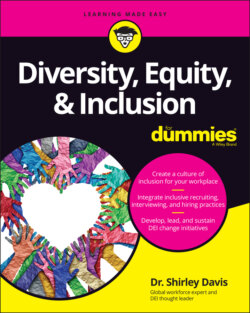Читать книгу Diversity, Equity & Inclusion For Dummies - Dr. Shirley Davis - Страница 16
Multiple dimensions of diversity
ОглавлениеIn 1990, well-respected diversity pioneers Marilyn Loden and Judy Rosener developed a framework for thinking about the different dimensions of diversity within individuals and institutions. Depicted as concentric circles, their diversity wheel has been used in many different ways to encourage thinking about values, beliefs, and dimensions of identity for people and organizations. It defines the various dimensions of diversity, dividing them into four layers:
Dimension 1 — Personality: Openness, conscientiousness, extraversion, agreeableness, neuroticism
Dimension 2 — Internal/Primary Dimensions: Age, gender, sexual orientation, physical ability, ethnicity, race
Dimension 3 — External Dimensions: Geographic location, income, personal habits, recreational habits, religion, educational background, work experience, appearance, parental status, marital status
Dimension 4 — Organizational Dimensions: Functional level, work content field, division/department/unit/group, seniority, work location, union affiliation, management status
At the core of these concentric circles is personality — the innately unique aspect that gives each person their own particular style. This core aspect permeates all other layers. Moving out from that center are the internal factors, the primary dimensions of diversity. These aspects are the ones you have little or no control over. The next level, secondary dimensions, is made up of external, personal, and societal influences. The fourth dimension encompasses organizational influences such as the type of work you do, your level in the organization, seniority, and so on.
I hope what you take away from this framework is that it represents who we are from our core dimensions and those that cannot be changed, to those dimensions that we develop over time. This leads to our assumptions, drives our own behaviors, and ultimately impacts others. So, the better we understand ourselves and others, the more effective our interactions and decisions will be.
